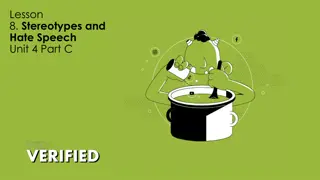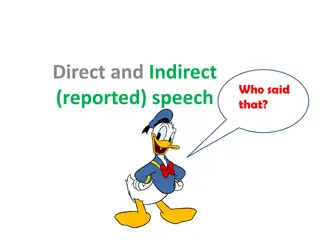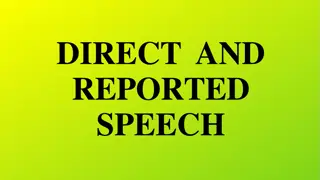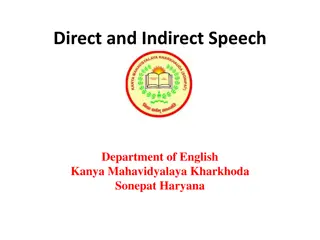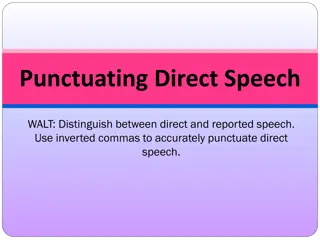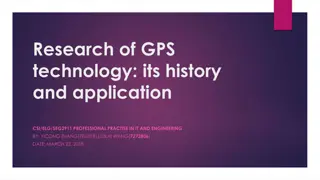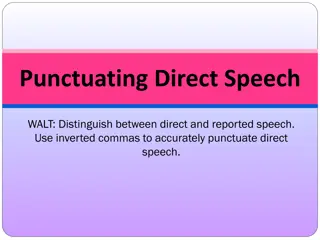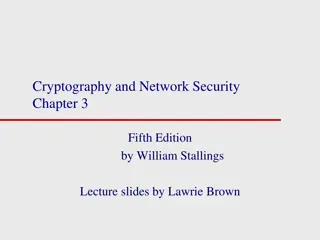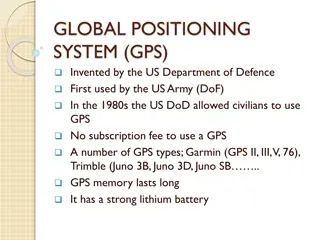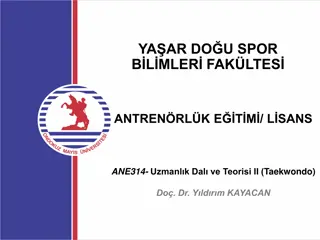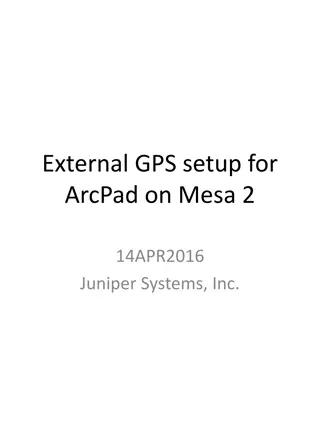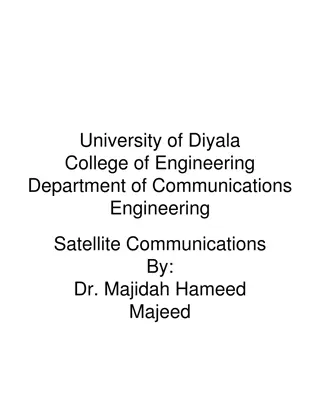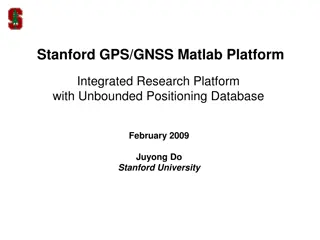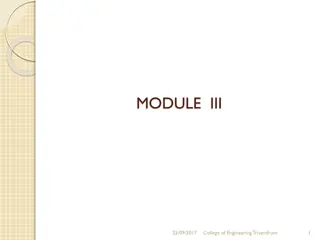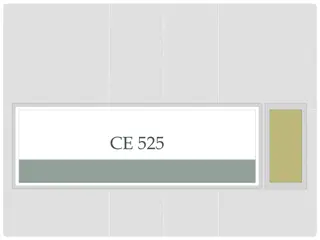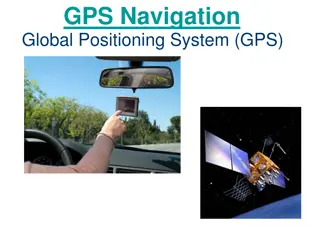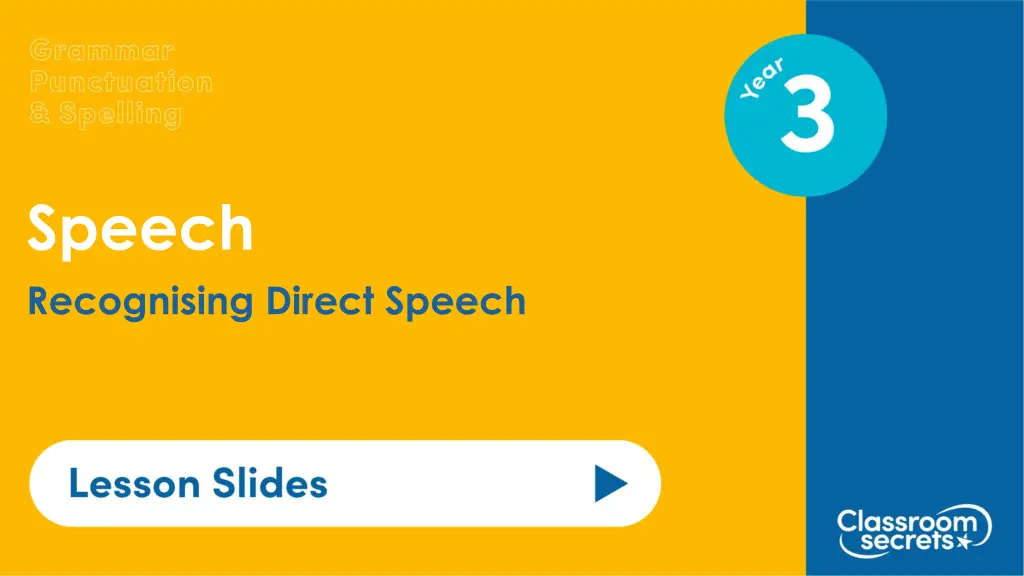
Understanding Direct Speech: Techniques and Examples
Learn about direct speech, including the use of inverted commas to indicate speech, reporting clauses, and differentiating action verbs from linking verbs. Practice sorting verbs into categories and recognizing direct speech in sentences. Gain insights into the importance of using inverted commas correctly.
Download Presentation

Please find below an Image/Link to download the presentation.
The content on the website is provided AS IS for your information and personal use only. It may not be sold, licensed, or shared on other websites without obtaining consent from the author. If you encounter any issues during the download, it is possible that the publisher has removed the file from their server.
You are allowed to download the files provided on this website for personal or commercial use, subject to the condition that they are used lawfully. All files are the property of their respective owners.
The content on the website is provided AS IS for your information and personal use only. It may not be sold, licensed, or shared on other websites without obtaining consent from the author.
E N D
Presentation Transcript
Speech Recognising Direct Speech
Key Information Direct speech is shown by writing exactly what was spoken between inverted commas. For example: "Hello!" said Shilo. Inverted commas (") are punctuation marks which show where speech begins and ends. They are also known as speech marks. A reporting clause is the part of a sentence which states who is speaking or thinking. For example: David wondered; Shabir asked; Tommy whispered.
Lets start with a question about the different types of verbs, which is linked to the new learning later in this lesson.
Complete the table by sorting the verbs into the correct category. is clapping skipping likes have sounds colouring playing Action verbs Linking verbs
Complete the table by sorting the verbs into the correct category. is clapping skipping likes have sounds colouring playing Action verbs Linking verbs clapping is skipping have colouring sounds playing likes The table should be completed as shown above.
Now that we are ready to move on, we can learn about recognising direct speech.
In this lesson, we will be learning about recognising direct speech. Direct speech is used to show that someone is speaking. Where is the report? Sandra asked her secretary. I m not sure. I left it on your desk yesterday evening, Jordan replied timidly. The direct speech has been highlighted to show what Sandra and Jordan have said to each other.
We use inverted commas ( ) to show when direct speech has been used. One set of inverted commas is used to show that the speech has started. How are you And another set is used to show that the speech has finished. How are you today? We must always remember to use two sets of inverted commas to show when speech has started and finished.
Select the sentences that use direct speech. Johnny was running down the street and shouting. I ve had enough of this! The fans chanted songs during the game. Is it almost time to start?
Select the sentences that use direct speech. Johnny was running down the street and shouting. I ve had enough of this! The fans chanted songs during the game. Is it almost time to start? We can see these sentences use direct speech because of the inverted commas.
Highlight the direct speech in the sentences below. Please turn the light on, Marcus whispered nervously. Leave me alone! Daisy screeched. How will we get to the top of the mountain? queried Ali worriedly. Simran laughed loudly, That was a great joke!
Highlight the direct speech in the sentences below. Please turn the light on, Marcus whispered nervously. Leave me alone! Daisy screeched, How will we get to the top of the mountain? queried Ali worriedly. Simran laughed loudly, That was a great joke! All of the spoken parts are inside the sets of inverted commas. This is how we can recognise direct speech.
As we can see from the previous examples, sentences that use direct speech are usually made up of two parts. One part is made up of speech and inverted commas. The other part is known as the reporting clause. Leave me alone! Daisy screeched. How will we get to the top of the mountain? queried Ali worriedly. Simran laughed loudly, That was a great joke!
We do not include the reporting clause in the inverted commas because it has not been spoken aloud. This means it is not part of the direct speech. That water is very refreshing, claimed Bec. The words that have been spoken. (Direct speech) Who said them and how they were said. (Reporting clause) The reporting clause is still important, however, as it gives more information to the reader about who has spoken and how they have said.
Sometimes, the reporting clause can be placed before the direct speech. How will we get to the top of the mountain? queried Ali worriedly. Simran laughed loudly, That was a great joke! This has no effect on the meaning of the sentence but we must ensure that we check the position of the reporting clause before we use inverted commas.
When reporting how the direct speech has been spoken, we usually use the word said . To ensure we use a wide range of vocabulary, we can use the words shown in the word bank below. Words instead of said called implied uttered mumbled told suggested stated replied explained claimed
Highlight the direct speech in the passage below. We must be quick so we can have more time to enjoy our drinks at the caf , informed Jayne as she entered the shop with Helen and Rebecca. Ok, I want you to get the milk, sugar and eggs, Rebecca directed. Rebecca, can you get the bread, fruit and ice cream? questioned Helen. Rebecca replied, Of course! The women quickly scurried off in different directions.
Highlight the direct speech in the passage below. We must be quick so we can have more time to enjoy our drinks at the caf , informed Jayne as she entered the shop with Helen and Rebecca. Ok, I want you to get the milk, sugar and eggs, Rebecca directed. Rebecca, can you get the bread, fruit and ice cream? questioned Helen. Rebecca replied, Of course! The women quickly scurried off in different directions. These are the sentences we must highlight.
Select the sentences that use inverted commas to show direct speech correctly. Layla, bring your PE kit on Tuesday, said the teacher. I m stuck in traffic, moaned Archie. Sam whispered, That was a great performance. Delilah screamed, I can t wait for my next holiday!
Select the sentences that use inverted commas to show speech correctly. Layla, bring your PE kit on Tuesday, said the teacher. I m stuck in traffic, moaned Archie. Sam whispered, That was a great performance. Delilah screamed, I can t wait for my next holiday!
Now that we can recognise direct speech, lets apply our learning to some further application and reasoning questions.
Violet is looking at the passage below. She has been asked to underline the direct speech in the sentences below. Cleo and his family were ready to have an incredible day at a new theme park. Outside the park gates Cleo and his family were eagerly waiting. Are you ready and raring to go? asked Cleo s dad. I was born ready, dad, replied Cleo proudly. Has Violet underlined the direct speech sentences correctly? Explain how you know.
Violet is looking at the passage below. She has been asked to underline the direct speech in the sentences below. Cleo and his family were ready to have an incredible day at a new theme park. Outside the park gates Cleo and his family were eagerly waiting. Are you ready and raring to go? asked Cleo s dad. I was born ready, dad, replied Cleo proudly. Has Violet underlined the direct speech sentences correctly? Explain how you know. No, Violet has not underlined the sentences correctly because she has underlined the reporting clause as well as the direct speech. The sentences that she should have underlined are: Are you ready and raring to go? I was born ready, dad,
Complete the speech bubbles to show which words Sabrina and Daniel have said aloud. Run as fast as you can! shouted Sabrina loudly. Daniel replied, They ll never catch us! Sabrina Daniel
Complete the speech bubbles to show which words Sabrina and Daniel have said aloud. Run as fast as you can! shouted Sabrina loudly. Daniel replied, They ll never catch us! Run as fast as you can! They ll never catch us! Sabrina Daniel
Youre ready to progress! Now apply your learning by trying some questions.
Identify the words that are being spoken in the sentence below and write them in the speech bubble. You re not meant to eat it! giggled Lex, as Greg quickly spat the mixture out. Lex Varied Fluency 1
Identify the words that are being spoken in the sentence below and write them in the speech bubble. You re not meant to eat it! giggled Lex, as Greg quickly spat the mixture out. You re not meant to eat it! Lex Varied Fluency 1
Underline the speaking verb and who is speaking. I didn t see anything, lied Marie, so don t ask me who did it! Varied Fluency 2
Underline the reporting clause. I didn t see anything, lied Marie, so don t ask me who did it! Lied Marie is the reporting clause. Varied Fluency 2
Add any missing inverted commas to the sentences below. The 9a.m. train to London is late. Mr Davis was furious. This was his third late train of the week! Varied Fluency 3
Add any missing inverted commas to the sentences below. The 9a.m. train to London is late. Mr Davis was furious. This was his third late train of the week! Varied Fluency 3
Underline the parts of the text that are being spoken. Here it comes! beamed Prince Aydal. It looks so tasty! The cooks brought in the cake on an enormous tray. The prince watched them closely, then squeaked, It s wobbling! Varied Fluency 4
Underline the parts of the text that are being spoken. Here it comes! beamed Prince Aydal. It looks so tasty! The cooks brought in the cake on an enormous tray. The prince watched them closely, then squeaked, It s wobbling! Varied Fluency 4
Use the words in two of the boxes to complete the direct speech below. George looked out of the foggy window. __________________________________ he exclaimed, pointing frantically. __________________________________ Let s build a snowman! What is that book about? Look at all the snow! Application 1
Use the words in two of the boxes to complete the direct speech below. George looked out of the foggy window. Look at all the snow! he exclaimed, pointing frantically. Let s build a snowman! Let s build a snowman! What is that book about? Look at all the snow! Application 1
Amy thinks she has written direct speech correctly in her recount. I came home from school and put my bag on the kitchen table. I went over to the oven, where my dad was stirring something in a pan. I hope it s spaghetti bolognese, I said, that s my favourite. Is Amy correct? Explain your answer. Reasoning 1
Amy thinks she has written direct speech correctly in her recount. I came home from school and put my bag on the kitchen table. I went over to the oven, where my dad was stirring something in a pan. I hope it s spaghetti bolognese, I said, that s my favourite. Is Amy correct? Explain your answer. No, she is incorrect because Reasoning 1
Amy thinks she has written direct speech correctly in her recount. I came home from school and put my bag on the kitchen table. I went over to the oven, where my dad was stirring something in a pan. I hope it s spaghetti bolognese, I said, that s my favourite. Is Amy correct? Explain your answer. No, she is incorrect because she has included the reporting clause inside the inverted commas. Reasoning 1
Which words are being spoken in the passage below? It was a sunny day so the boys decided to go to the park. Let s take a football, Tom suggested, and our skateboards. The other boys nodded. Explain how you know. Reasoning 2
Which words are being spoken in the passage below? It was a sunny day so the boys decided to go to the park. Let s take a football, Tom suggested, and our skateboards. The other boys nodded. Explain how you know. The words, Let s take a football, and and our skateboards. are being spoken. I know this because Reasoning 2
Which words are being spoken in the passage below? It was a sunny day so the boys decided to go to the park. Let s take a football, Tom suggested, and our skateboards. The other boys nodded. Explain how you know. The words, Let s take a football, and and our skateboards. are being spoken. I know this because those words are inside a pair of inverted commas. They also have a reporting clause. Reasoning 2

